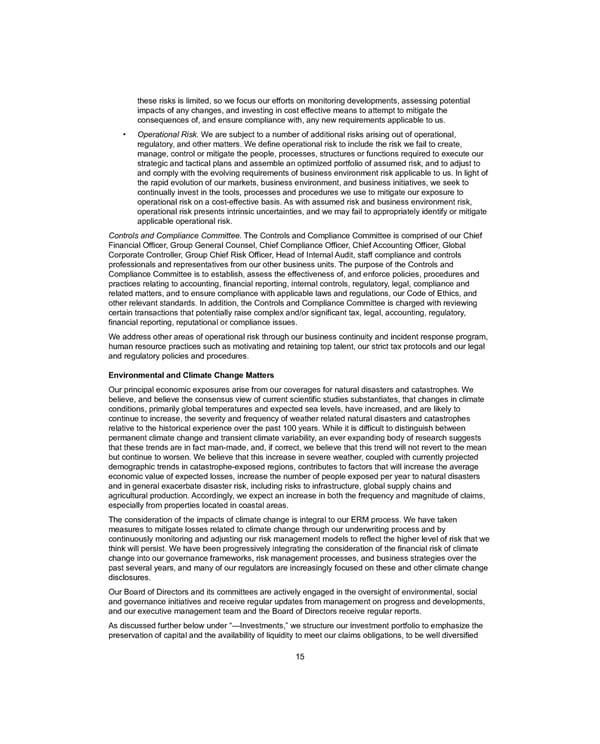these risks is limited, so we focus our efforts on monitoring developments, assessing potential impacts of any changes, and investing in cost effective means to attempt to mitigate the consequences of, and ensure compliance with, any new requirements applicable to us. • Operational Risk. We are subject to a number of additional risks arising out of operational, regulatory, and other matters. We define operational risk to include the risk we fail to create, manage, control or mitigate the people, processes, structures or functions required to execute our strategic and tactical plans and assemble an optimized portfolio of assumed risk, and to adjust to and comply with the evolving requirements of business environment risk applicable to us. In light of the rapid evolution of our markets, business environment, and business initiatives, we seek to continually invest in the tools, processes and procedures we use to mitigate our exposure to operational risk on a cost-effective basis. As with assumed risk and business environment risk, operational risk presents intrinsic uncertainties, and we may fail to appropriately identify or mitigate applicable operational risk. Controls and Compliance Committee. The Controls and Compliance Committee is comprised of our Chief Financial Officer, Group General Counsel, Chief Compliance Officer, Chief Accounting Officer, Global Corporate Controller, Group Chief Risk Officer, Head of Internal Audit, staff compliance and controls professionals and representatives from our other business units. The purpose of the Controls and Compliance Committee is to establish, assess the effectiveness of, and enforce policies, procedures and practices relating to accounting, financial reporting, internal controls, regulatory, legal, compliance and related matters, and to ensure compliance with applicable laws and regulations, our Code of Ethics, and other relevant standards. In addition, the Controls and Compliance Committee is charged with reviewing certain transactions that potentially raise complex and/or significant tax, legal, accounting, regulatory, financial reporting, reputational or compliance issues. We address other areas of operational risk through our business continuity and incident response program, human resource practices such as motivating and retaining top talent, our strict tax protocols and our legal and regulatory policies and procedures. Environmental and Climate Change Matters Our principal economic exposures arise from our coverages for natural disasters and catastrophes. We believe, and believe the consensus view of current scientific studies substantiates, that changes in climate conditions, primarily global temperatures and expected sea levels, have increased, and are likely to continue to increase, the severity and frequency of weather related natural disasters and catastrophes relative to the historical experience over the past 100 years. While it is difficult to distinguish between permanent climate change and transient climate variability, an ever expanding body of research suggests that these trends are in fact man-made, and, if correct, we believe that this trend will not revert to the mean but continue to worsen. We believe that this increase in severe weather, coupled with currently projected demographic trends in catastrophe-exposed regions, contributes to factors that will increase the average economic value of expected losses, increase the number of people exposed per year to natural disasters and in general exacerbate disaster risk, including risks to infrastructure, global supply chains and agricultural production. Accordingly, we expect an increase in both the frequency and magnitude of claims, especially from properties located in coastal areas. The consideration of the impacts of climate change is integral to our ERM process. We have taken measures to mitigate losses related to climate change through our underwriting process and by continuously monitoring and adjusting our risk management models to reflect the higher level of risk that we think will persist. We have been progressively integrating the consideration of the financial risk of climate change into our governance frameworks, risk management processes, and business strategies over the past several years, and many of our regulators are increasingly focused on these and other climate change disclosures. Our Board of Directors and its committees are actively engaged in the oversight of environmental, social and governance initiatives and receive regular updates from management on progress and developments, and our executive management team and the Board of Directors receive regular reports. As discussed further below under “—Investments,” we structure our investment portfolio to emphasize the preservation of capital and the availability of liquidity to meet our claims obligations, to be well diversified 15
 2021 Annual Report Page 30 Page 32
2021 Annual Report Page 30 Page 32